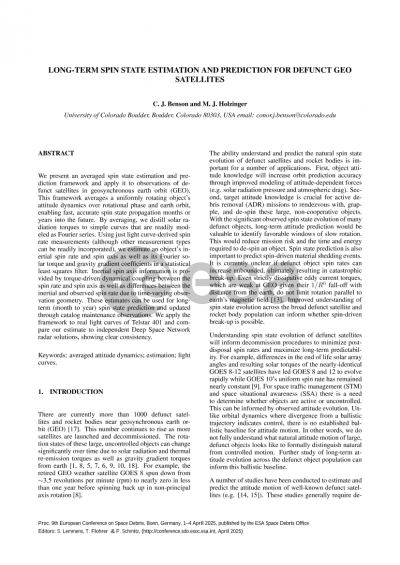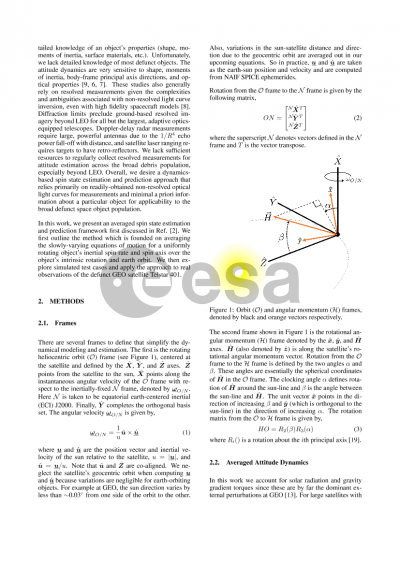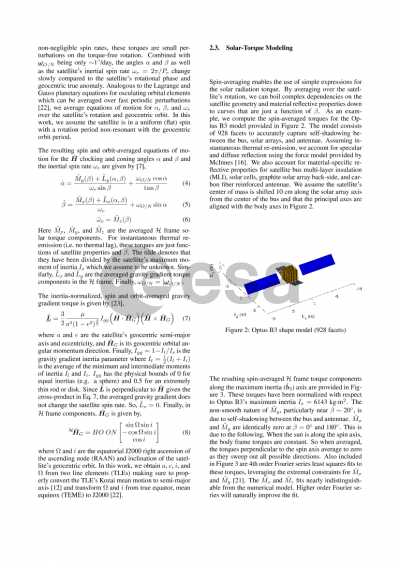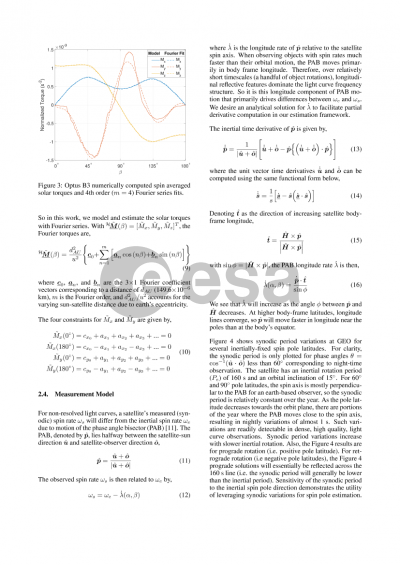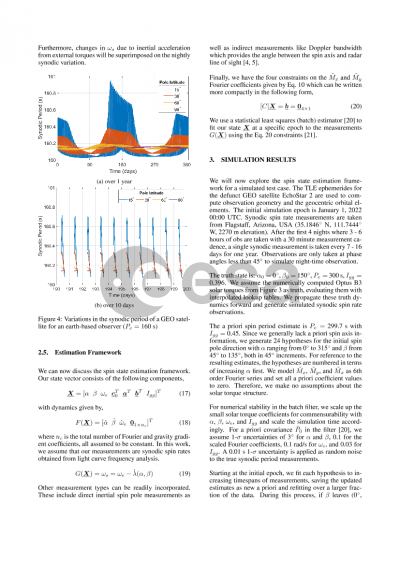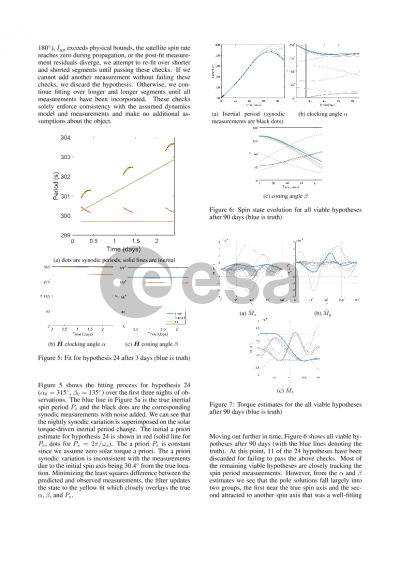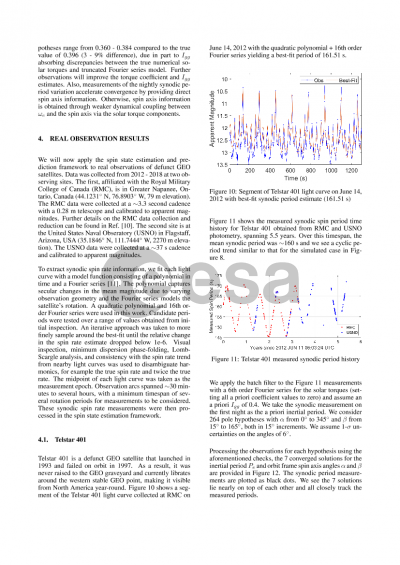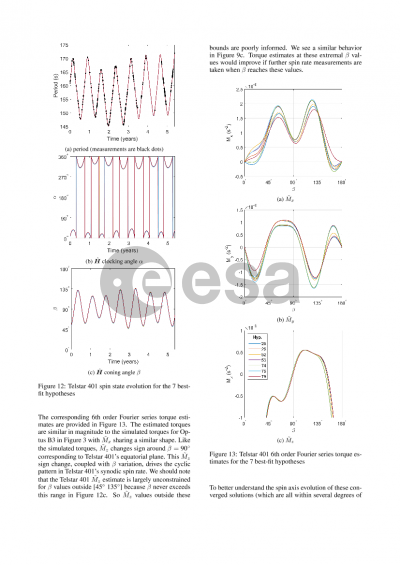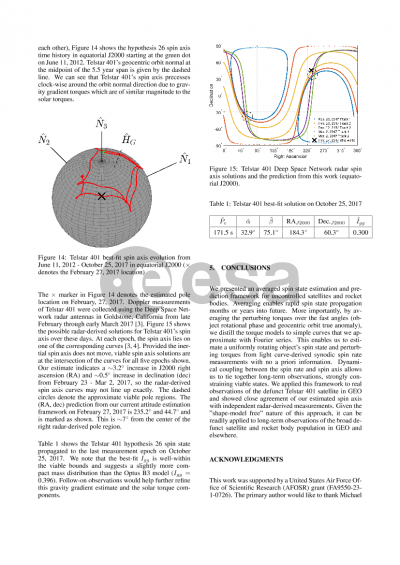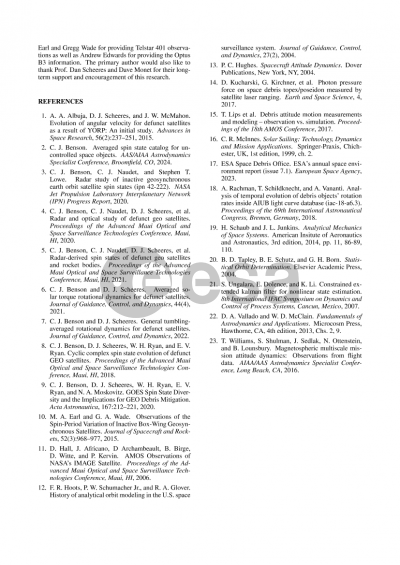Document details

Abstract
We present a spin state catalog framework for defunct satellites that leverages averaged attitude dynamics and light curve-derived spin rate measurements to estimate an object’s inertial spin rate, spin axis, and natural torques for long-term (month to year) spin state prediction.
There are over 1000 defunct satellites and rocket bodies near geosynchronous earth orbit (GEO) [1]. The spin states of these objects can change significantly over time due to natural perturbations, most notably solar radiation torques [2-5]. Estimating and predicting these evolving spin states is valuable for several efforts. First, attitude knowledge will enhance modeling of attitude-dependent forces for improved orbit prediction. Second, active debris removal (ADR) missions will require target attitude knowledge to grapple and de-spin these large, non-cooperative objects. With evolving spin states, the ability to predict windows of slow rotation would be advantageous for ADR mission planning. Also, spin state evolution is highly sensitive to object shape, mass, and optical properties as well as end of life configurations (e.g. solar array angles) [3]. So, understanding spin state evolution for the broad defunct satellite population can inform spacecraft design and passivation procedures to minimize post-disposal spin rates. Spin state forecasting would also enable prediction of rapid object rotation that could lead to material shedding or fragmentation.
Several efforts have estimated and predicted the spin states of defunct low earth orbit (LEO) satellites, for example Envisat and Topex-Poseidon [6-7]. These efforts relied on detailed prior knowledge of each objects’ shape, mass, and optical properties as well as laser ranging, radar, and/or resolved imagery. We lack precise knowledge of these properties for most objects and cannot readily obtain active/resolved measurements for the broad space object population. Most objects lack laser retro-reflectors, and, beyond LEO, ground-based radar and resolved imagery require large aperture sensors to overcome power and angular resolution challenges. To estimate and predict spin states for the broad population, a framework is needed that: 1) requires minimal a priori object knowledge, and 2) leans primarily on ubiquitous non-resolved optical light curves for measurements.
We present and expand on a spin state estimation and prediction catalog framework for uniformly rotating defunct satellites and rocket bodies [8]. This “shape model free” framework is founded on averaged attitude dynamics [3,5]. By averaging the natural torques over an object’s rotation, we can simplify complex shape, mass, and optical property dependencies to constant torque curves that are readily modeled and estimated as Fourier series. As a result, little to no object a priori information is needed. Averaged dynamics also enable rapid spin state propagation. For measurements, we use spin rates extracted from light curve data. By modeling differences between the observed and inertial spin rate due to time-varying observation geometry, we can obtain direct spin axis information. Coupling of the spin rate and spin axis equations of motion due to solar and gravity gradient torques provides additional spin axis information. By leveraging averaged dynamics and ubiquitous light curve data, this shape-free framework can be readily applied to the uncontrolled satellite and rocket body populations in GEO and elsewhere.
We apply the framework to real observations of several defunct GEO satellites, estimating each satellite’s inertial spin rate, spin axis, and solar radiation and gravity gradient torque coefficients in a statistical batch filter. These state estimates can be used for long-term (month to year) spin state prediction and updated through catalog maintenance with follow-on observations.
[1] “ESA’s Annual Space Environment Report (Issue 8.0)”, ESA Space Debris Office, European Space Agency, 2024.
[2] M. A. Earl and G. A. Wade, “Observations of the Spin-Period Variation of Inactive Box-Wing Geosynchronous Satellites”, Journal of Spacecraft and Rockets, 2015.
[3] C. J. Benson, D. J. Scheeres, et al., “GOES Spin State Diversity and the Implications for GEO Debris Mitigation”, Acta Astronautica, 2020.
[4] C. J. Benson et al., “Radar-Derived Spin States of Defunct GEO Satellites and Rocket Bodies”, AMOS Conference, 2021.
[5] C. J. Benson and D. J. Scheeres, “General Tumbling-Averaged Rotational Dynamics for Defunct Satellites”, Journal of Guidance, Control, and Dynamics, 2022.
[6] T. Lips et al., “Debris Attitude Motion Measurements and Modeling – Observation vs. Simulation”, AMOS Conference, 2017.
[7] D. Kucharski, et al., “Photon Pressure Force on Space Debris TOPEX/Poseidon Measured by Satellite Laser Ranging”, Earth and Space Science, Vol. 4, 2017.
[8] C. J. Benson, “Averaged Spin State Catalog for Uncontrolled Space Objects”, AAS/AIAA Astrodynamics Specialist Conference, 2024.
Preview
